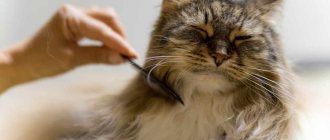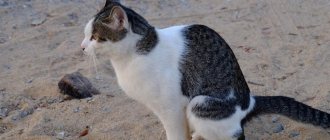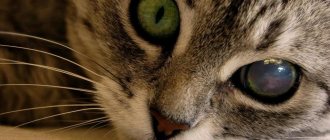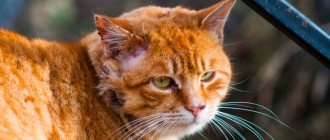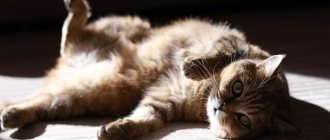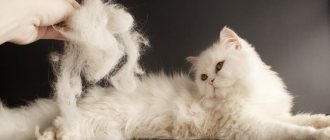If a cat loses some of its fur, this is normal and a natural process. However, in situations where the amount of hair on the floor and surrounding objects increases, and the hairiness of a domestic cat, on the contrary, decreases, this is a reason to think about the state of the animal’s health.
Some causes of hair loss are completely harmless, but others can be serious.
So, the cat's hair is falling out. The main reasons can be: natural (molting, age-related), health problems (poor diet, hormonal imbalance, allergies), parasites (worms, lice eaters, subcutaneous and scabies mites), problems with the immune system.
Natural causes
First, you need to pay attention to the appearance of the animal and its general condition in order to determine the causes of hair loss. The main signs that a cat is healthy include:
- the animal’s nose is moist and of a color usually characteristic of it;
- the eyes are clean, clear, without any discharge;
- there is no irritation on the skin, it is of normal color;
- The animal’s behavior is cheerful and no different from everyday behavior.
With all these signs, we can say for sure that the cat is just having a normal shedding.
The cat is losing hair in clumps and has sores on the skin: causes and treatment
When a fungal infection occurs, the body becomes covered with small bald spots with round skin flakes. Ringworm is contagious to people; self-medication is strictly prohibited; laboratory tests will determine exactly what treatment will relieve the cat of the disease.
With seborrhea, the skin acquires an unpleasant odor, increased oiliness, and becomes inflamed. A scraping and blood test will help diagnose it. Erythema multiforme appears as a side pathology in oncology and other diseases. Ulcers, depression, watery blisters in the groin, armpits, profuse hair loss are its signs.
Solar dermatosis is more common in white-eared individuals; the skin turns red, peels, and later wounds appear.
Sores in a cat due to hair loss can occur when:
- alopecia areata;
- psychogenic, injection alopecia;
- folliculitis;
- sweat gland cysts.
It is not possible to diagnose the correct cause on your own; in any case, you need to consult a specialist, examine your skin and blood.
Shedding
If a cat's fur falls out in clumps, the reasons may be very trivial. Animals in the wild change their coat twice a year: in autumn and spring. In domestic animals, this process is disrupted, since they are removed from their natural habitat. For example, in the fall, when all animals in nature build up a warm undercoat for winter, the reverse process begins in domestic cats. This is due to the fact that the heating is turned on during this period of time. The air in the apartment becomes hot and dry, so your pet is in a hurry to get rid of excess fur. Moreover, at home, the molting process can take much longer than in natural conditions. This is completely normal. The fact that an animal is actively changing its coat is not a cause for concern.
All you need to do is make sure that your cat's diet is balanced and rich in vitamins and minerals. If there are not enough of them in the diet, you can compensate for this deficiency. It is enough to purchase special vitamin and mineral complexes at any pet store.
You need to comb the animal more often. On normal days, sessions should be carried out once every 7-30 days, but when the molting period begins, the procedure becomes daily. And if your pet has long hair, you will have to comb it twice a day. And even this will not get rid of the daily use of a vacuum cleaner.
What to do, what to feed, what to give to a cat to prevent hair from coming out?
When a cat has a problem with hair loss, owners ask themselves: what to do? Your actions in this case are mandatory; inaction can lead to deterioration in the health of the pet, and sometimes other household members.
First of all, make sure that it is not shedding. If you see that the problem is serious, analyze the animal's diet. Create a menu for your cat:
- Introduce low-fat varieties of fish, meat, offal, cottage cheese and milk into your diet.
- Don't give your cat milk instead of water. Milk should act as a separate food, no more than 1-2 times a week.
- Do not overfeed cats, especially older ones.
If your cat is used to ready-made food, it may be worth buying a higher quality food. There is also a special medicated food for cats prone to dermatitis. It is impossible to find out exactly which vitamin an animal lacks at home. This requires a visit to the veterinary clinic.
A rich diet and balanced nutrition are the key to healthy cats
In the case when the cat’s hair falls out and the cat’s skin itches due to allergies, you can add ⅛ of a suprastin tablet to the food 2 times a day. The source of the allergy, of course, needs to be found out and removed.
There are special vitamins for cats that can be given during the molting period, as well as for hormonal disorders. An experienced veterinarian will tell you what is best to give specifically in your case.
If you see that a balanced diet is not helping and your cat is losing more and more fur, consult a doctor. Do not neglect consulting a specialist, because a cat’s skin disease can be transmitted to people, for example, mycosis. Correct diagnosis and prescription of suitable treatment will help your pet to be cured faster.
If your pet has been found to have lichen, lice and other parasites that live on the body, take care not only of treatment, but also of disinfection of the home. Furniture and carpets should be thoroughly disinfected, and the animal's bedding should be replaced with new one.
What to do if your cat is going bald?
Age
It is very important for owners to understand as early as possible why cats lose hair in clumps. The reasons can be completely different, from dangerous to completely harmless. Baldness of the muzzle and partial loss of hair are another common condition of the animal. This process manifests itself in pets aged from 14 months to 20. This condition is caused by quite normal age-related changes in the coat. When the animal reaches the appropriate age, this phenomenon will go away on its own, so you should not run to the veterinarian.
Poor nutrition
At any age, the animal's diet must be balanced. Feeding from your own table is the most common mistake a pet owner makes. With this approach, the animal’s bowl may contain everything that is strictly prohibited for cats: fried foods, sausages, various scraps, leftover salty and fatty foods.
The answer to the question of why a cat's fur falls out in clumps may be a simple desire to save money. For example, the owner buys dry food from the cheapest line. Yes, such food will help your pet get enough, but it will also bring many health problems. After all, its composition is not always optimal, so the effect of such food on the animal’s body can be destructive.
It is worth understanding that choosing a diet is a very important process. It is better to choose dry food from the super-premium or premium category. This diet is balanced and contains all the necessary microelements. Although it costs, of course, more than advertised budget products. But using low-quality food will cost much more, as it will provoke a trip to the veterinarian and long-term treatment.
To determine why a cat’s hair is falling out in clumps, and to understand that the reason lies precisely in the food and improper diet, it is necessary to take into account the following symptoms:
- the main pieces of hair fall out on the back, neck and tail;
- on all other parts of the body the fur began to fade;
- discharge appeared from the eyes, and they themselves became cloudy;
- the ears are inflamed and itchy;
- The bald spots that have arisen at the site of the fallen tufts are inflamed and itchy, the layers of skin in these places have begun to peel off, the animal scratches itself so that sores appear.
Unusual shedding or something more serious?
The natural coat of a healthy domestic cat is the pride of its owners. After all, our care and love, which we express in caring for our pet, will certainly be reflected in the condition of the coat. We buy food, thinking about the characteristics of the purr: how old is she, how does she tolerate cold or heat, is she neutered, what conditions does she live in, what is her daily routine.
In the same way, we carefully and carefully approach the choice of shampoos, brushes, sleeping place, toys and everything else, without which a cat’s life would be not only dull, but also impossible. All this is reflected in the shine of the pet’s coat and skin condition. We even learned how to deal with shedding. We are successfully surviving this time together with the cat.
And so, against the backdrop of such care, we begin to notice that our cat’s hair is coming out in clumps. This may be a cause for concern. And the first thing we pay attention to is whether the cat’s behavior has changed?
Try to take a closer look at your cat and answer these questions:
- Has she become nervous?
- How does she eat, does she have an appetite? And if there is no appetite, will the cat eat its favorite delicacies?
- Did she begin to itch more and pull out tufts of fur? Or does the hair fall out on its own, leaving bald patches?
- Are there any pronounced wounds in place of the bald spots?
- Maybe it was all our imagination, and the only scrap that came out of the cat was due to an accidental injury?
© shutterstock
Even by simply answering all the questions, you can get the answer, what is in front of us? Problem? And the cat, combing out its fur in clumps, clearly demonstrates this to us, as if asking for help. She withers and weakens when she refuses to play and her favorite fish. Or, there is no reason to worry and this is a type of molting.
One important fact for everyone who has a cat or is just thinking about getting one! Different breeds shed differently . Some more intensively, with almost complete replacement of wool and undercoat. And their fur sheds throughout the year, and especially during the seasonal coat change. Some cat breeds experience moderate hair loss, and only before a change in air temperature. And there are those who shed only a few times in their entire lives, or don’t do so at all.
Correcting the situation
Solving this problem is quite simple: it is necessary to adjust the pet’s diet in accordance with its needs, and replace low-quality food with healthier ones.
There are situations where hair begins to fall out even when the cat eats a high-quality product. This may be due to individual intolerance to a certain food. In this case, you just need to replace it with another one. Its class should be the same, but the composition is different or even a completely different manufacturer.
Preventive measures
The quality of the coat is an indicator of the health of the cat. If an animal is losing a lot of hair, it is important to notice it promptly and take action. The main measures that the owner can take to keep the cat beautiful and fluffy:
- Selection of a balanced diet. Natural food should contain all the necessary vitamins. Dry and wet food must be of high quality, specially developed in accordance with age, condition (pregnancy, castration, sterilization), concomitant disease - medicinal lines of food.
- Antihelminthic courses. Veterinarians recommend every 3 months.
- Use anti-flea collars or regular treatment with special drops.
- Mandatory vaccination.
- Elimination of foods and items that cause allergies.
- Proper care – regular brushing and grooming.
- Maintaining cleanliness in the room.
Caring for and caring for your cat will keep it healthy for a long time.
For timely detection of hidden pathologies, veterinarians recommend taking tests every year. Elderly and weakened cats with chronic diseases need to visit a veterinary clinic twice a year.
Caring for your pet will help you avoid serious illnesses. Only if you follow all the recommendations, the cat will have a beautiful, thick coat and a healthy appearance.
Hormonal disbalance
This situation most often occurs due to the use of hormonal drugs, such as drops or tablets, which reduce the animal’s sex drive. Thanks to these means, the pet stops marking its territory and demanding a partner. However, such violent interference with hormonal levels does not pass without leaving a trace. If, after using such drugs, a cat’s hair falls out in clumps to the point of bald spots, the cat becomes lethargic, indifferent, eats poorly, and begins to see or hear worse, in most cases this indicates that a hormonal imbalance has occurred. This problem should be solved by a veterinarian by prescribing corrective therapy. Timely sterilization or castration allows you to avoid such problems.
Allergy
In most cases, as in humans, an allergic reaction in an animal manifests itself on the skin. The hair falls out symmetrically in parallel, redness appears on the skin, and the ears become inflamed and itchy. Most often, allergies are caused by some food product, including feed. In such cases, the diet is simply adjusted.
But the problem may not always be food. Allergies can occur to grooming products or to the material from which the bedding or bowl is made. If the allergy is not related to food, you need to temporarily limit the animal from all its things. After the allergy has stopped, you should return one item at a time and carefully observe, after which the allergic reaction will appear again. Accordingly, this item will subsequently need to be removed from the cat’s everyday life.
Parasites
It is a mistake to think that an animal can become infected with parasites only by living outdoors. Therefore, preventive measures are often not applied to pets that do not leave the apartment. But parasites can get into the house on people’s clothes and shoes. And then safely transfer to the animal. Several signs that help determine that an animal has parasites:
- The pet's behavior becomes nervous, it itches very often and severely, which even leads to the appearance of wounds.
- The hair falls out, but not very much.
- The direct presence of parasites on an animal is the most obvious sign of their presence.
What to do when your pet is shedding
Each hair is “born” from a follicle, which is in a state of activity, forming the structure of the hair. When it grows, a resting phase begins; the hair does not lengthen, but remains in place. After 4-8 months, the hair dies and falls out. The peak of fur coat change occurs in the off-season.
Walking cats become warmer for winter, and before summer their fur coat becomes thinner. Pets can change the order of “changing clothes”: in the summer the air conditioners work in the apartment, and in the winter it becomes hot.
During this period, it is necessary to scratch the cat daily with a comb suitable for the type of fur; this will reduce the amount of hair left by the pet on furniture and carpets. Long-haired breeds (Persians, Maine Coons) develop mats without regular brushing. Cats try to keep themselves tidy and groom themselves.
Fur accumulates in the stomach, which the pet will regurgitate from time to time. To prevent a large accumulation of lumps in the gastrointestinal tract and problems with intestinal obstruction, you can give your pet special food that facilitates the removal of trichobezoars, phytomins, malt paste, or plant grass for cats in a pot.
Be sure to read:
Why does a cat bite and gnaw its tail strongly, sometimes until it bleeds? Should I be worried?
Fleas
The most common types of pests are fleas. These small, dark, shiny insects can be easily seen on your pet with the naked eye. They feed on blood. They bite through the skin in order to get to food. After such a meal, the bite site begins to itch, which causes a lot of anxiety to the animal. Starting to scratch itself, the cat tries to relieve the itching.
If fleas are found, you must get rid of them immediately, as they multiply very quickly.
Pooh-eaters
These parasites are also called lice eaters. Their food consists of particles of animal hair and skin. They are very difficult to spot as they are much smaller than fleas. Therefore, you can understand that a pet has acquired them only by the symptoms: the pet is nervous, sleeps poorly, bites its fur coat, stops listening, itches endlessly and loses its fur. If such signs occur, it is necessary to point the lamp at the animal and wait 10 minutes. If these parasites are present on the pet’s body, they will definitely come out closer to the warmth. And then it will be possible to see exactly why the cat’s clumps of hair fall out.
Subcutaneous mite
This parasite causes demodicosis. Damage is caused to both the animal's fur and its skin. There is no consensus yet on how exactly an animal becomes infected. Some suggest that the pet becomes infected from another sick animal. Others think that ticks are on the cat all the time, but only when its body weakens do they begin their destructive effect. The main sign that the parasite is active is hair loss. The lesions are located on the ears, eyebrows, near the mouth and nose, and the paws also suffer. Baldness gradually becomes more noticeable, and dermatitis appears.
Vitamin and mineral complexes for cat fur
The AVZ company offers a large selection of vitamins for cat fur. Our products have declarations of conformity and undergo strict controls at all stages of production. You can familiarize yourself with these documents in a special section of our website. And in our catalog you will find:
- vitamin and mineral complex "Radostin". Available in several variations - for kittens, for adult cats, for cats over 8 years old, for pregnant cats and for castrated cats. Having a balanced composition, it can be used as a prevention of vitamin deficiency or for treatment;
- solution for oral use "Vittri-1" is ideally balanced, created primarily for kittens, pregnant and lactating cats, providing their body with the necessary fat-soluble vitamins;
- "Fitodoc® Fish Oil" is a valuable source of polyunsaturated fatty acids, rich in omega-3 and omega-6. It is suitable for cats and kittens, ensures harmonious development, has a general strengthening effect and has a beneficial effect on hair follicles;
- “Grass for cats” is an environmentally friendly green food for pets who love to hunt their host’s plants. Contains many ballast substances, vitamins, stimulates digestion.
You can find these and other vitamins for cats against hair loss in our company’s catalog and purchase them at a competitive price from the manufacturer.
Worms
These parasites bring a huge number of problems to the body. Hair problems in this case are a secondary symptom. First the fur becomes dull and then falls out. Digestive problems arise, the animal experiences general weakness, bad breath, weakened immunity, and impaired appetite. If you do not treat your pet in time, it can lead to serious consequences and even death. It should also be understood that many types of worms are transmitted to humans. Therefore, prevention should be done in a timely manner.
A cat's hair is falling out in clumps to the point of bald patches: what to do?
When shedding, the hair falls out evenly; if bald spots appear, this is an alarming signal, often accompanied by:
- runny nose;
- lacrimation;
- poor appetite;
- loss of body weight with a normal diet;
- peeling of bare skin;
- itching, anxiety, irritability;
- elevated temperature;
- bowel disorders.
In this case, it is necessary to exclude all possible causes of dermatitis: change the diet, choose a different type of tray filler, limit the use of household chemicals and be sure to show the animal to a doctor.
Immunity problems
If an animal has problems with immunity, the fur is the first to suffer from this. This situation most often occurs when an animal is recovering after a long, protracted illness or surgery. In this case, nothing can be done. You just need to wait until the body itself starts working as before. However, in some cases it won't hurt to get some help.
In such situations, it is recommended to temporarily transfer the cat to a balanced natural diet of the highest quality. If a decline in immunity is the cause of hair loss in a cat, treatment by a veterinarian may be prescribed by adding a complex of vitamins and minerals to the diet. At such times, beneficial substances are very relevant, but a specific drug must be prescribed by a veterinarian. Otherwise, you may cause even more harm to your pet.
As you can see from the article, there can be many reasons for hair loss, and the symptoms are not always obvious and similar to each other. Therefore, a veterinarian must determine why a cat’s fur falls out in clumps and how to treat this or that disease. Trying to make a diagnosis yourself can only worsen the animal’s condition.
As soon as a question arises and concern arises about why the pet feels pain and why the cat’s hair is falling out on its back, it is better to immediately go to the veterinary office. There they will do tests, conduct research and thoroughly examine the animal. Skin diseases spread quite quickly, so do not delay your visit. In addition, all this is accompanied by severe itching. As a result, the pet begins to scratch itself, wounds appear on its skin, which can lead to infection.
Causes of severe hair loss in cats
Cats can lose hair for physiological and pathological reasons. In the first case, we are talking about a natural process in which you should not worry about the health of your pet. Physiological hair loss goes away on its own. At the same time, the animal looks quite healthy, does not lose its appetite and remains alert.
If the cause of molting is a pathological factor, then the condition of the skin often changes. In addition, the cat loses activity, may refuse food and hide in corners. If this happens, it is important to consult a doctor immediately.
Hair loss in cats can be caused by diseases
Attention! If your pet has a lot of hair loss, he becomes lethargic, eats little and has a dry and warm nose, then this may signal a pathological process occurring in the body. In this case, the cat must be taken to a veterinary clinic without waiting for life-threatening complications for the animal.
Why hair may fall out - video
Natural shedding
Active hair loss occurs during the shedding season, which occurs in spring and autumn. At the same time, the animal feels quite good. His coat is gradually renewed. This process causes a lot of inconvenience to the owners, but does not affect the pet’s health in any way. The skin does not change its normal color and remains pale pink.
An animal can also shed during pregnancy, as changes occur in the cat’s body. In addition, during this period immunity decreases, which can enhance this physiological process. Hair loss is also possible during lactation, since a large amount of vitamins and other nutrients are spent on milk production so that kittens grow strong and healthy.
A nursing cat loses a lot of hair, as vitamin deficiency in the body often occurs during lactation.
The problem can arise in older cats, because the body of this group of pets gradually weakens, which is why hair falls out regularly and out of season. However, active molting in an old animal should not be ignored. Such a pet should be properly fed and cared for.
In order to understand why shedding occurs and whether it is worth contacting a veterinarian, you should look at the appearance of the skin and fur. If there is focal baldness, affecting the eyes and ears, then this indicates the presence of the disease. You should immediately consult a doctor if the skin becomes red, irritated, and the coat becomes dull and unkempt.
My cat had long hair, during the molting period it grew so much that it became scary. They periodically gave the pet vitamins, but also constantly combed it. It is very important to do this, although previously this procedure was not given much importance. The fact is that if you don’t comb the fur, then during licking it gets into the cat’s gastrointestinal tract and can ultimately cause intestinal obstruction. I recommend everyone not to neglect this simple procedure.
What to do when your pet is shedding - video
Pathological loss
Pathological causes of active hair loss in cats:
- Stress. Shedding often intensifies due to nervous overstrain. Stress can be triggered by a sudden change in environment, vaccination, surgery, noisy parties, etc.
- Poor nutrition. A lack of essential vitamins and minerals in your pet’s diet can cause active hair loss.
- Allergy. Hair loss can occur due to a pathological reaction of the cat's body to various components. Allergies can be triggered by improper feeding and the use of poor-quality hygiene products. In this case, the fur may fall out unevenly, and the cat may experience severe itching.
- Taking medications. Active molting can be caused by long-term treatment with antibiotics, glucocorticosteroid drugs and potent agents that are used for application to the skin.
- Parasitic diseases. Hair loss can occur if the pet has worms in its body, as well as if it is infected with fleas, ticks and lice-eaters. Additionally, the animal may experience itching.
- Fungal infections. Microsporia and other diseases similar in etiology often provoke active molting. In this case, baldness often has a focal form. In this case, the fur falls out in clumps, and irritation appears on the skin.
- Bacterial and viral infections. The presence of pathogenic microflora in a pet’s body often leads to severe shedding, since the animal’s defenses are worn out during this period. In addition, there are additional symptoms: increased body temperature, loss of appetite, loss of activity, vomiting and diarrhea.
- Immunodeficiency states. A decrease in the body's defenses often provokes hair loss. At the same time, the pet looks lethargic and is susceptible to various infectious diseases. Deterioration of the immune system occurs with poor nutrition, in the postoperative period and with long-term treatment with antibacterial medications.
- Gastrointestinal diseases. Lesions in the cat's stomach and intestines contribute to poor absorption of vitamins from food, which causes deterioration in the appearance of the cat's fur and its loss. After treatment of the underlying disease, the problem is quickly eliminated.
- Kidney failure. Impaired functioning of the urinary system can contribute to a decrease in immune defense, as well as intoxication of the body. This occurs especially often in chronic renal failure. In this case, the entire body suffers, including the coat.
Fungal diseases in cats can cause hair loss
Attention! Hair falling out in clumps should alert you. If your pet has bald patches on certain parts of its body, this can be caused by ringworm, which is easily transmitted from animal to person.
My friend's cat lost hair on his withers. She didn't attach any importance to this. When I was visiting her, I noticed that the animal also had some kind of sore in this area. Unfortunately, the disease was so advanced that they did not have time to save the cat. I recommend that anyone with focal hair loss in pets immediately contact a veterinarian. Late discovery of the cause may cost the pet's life.
Causes of pathological shedding in kittens
Thinning coats in kittens may be associated with rare hereditary diseases. In this case, a genetic mutation occurs, which can provoke molting, which is not associated with seasonal changes in the pet’s body. If a kitten has this problem, it is important not to self-medicate, because it can cause life-threatening consequences for the animal.
What other factors can contribute to the development of pathology:
- insufficient intake of vitamins from food or mother's milk;
- premature birth;
- infectious diseases.
If a kitten loses hair in large quantities, this may be a sign of insufficient intake of vitamins in the body.
The kittens' body is very sensitive to the slightest external irritants, so a sudden change in food can negatively affect not only the pet's well-being, but also its coat. Therefore, you should not change the animal’s diet unless necessary, and also do not give medications without a doctor’s prescription.





